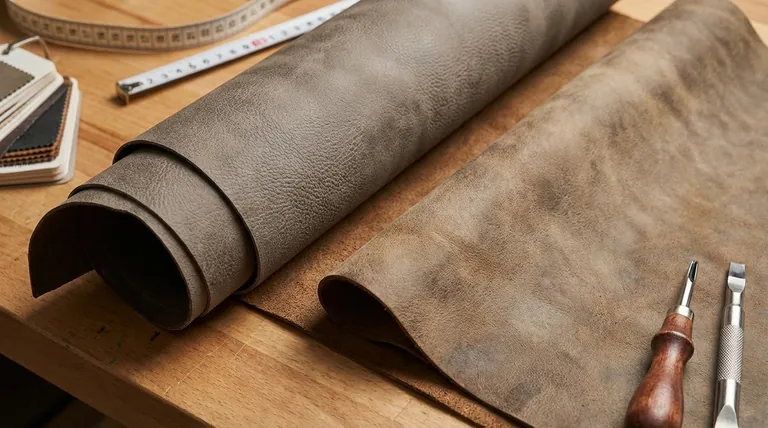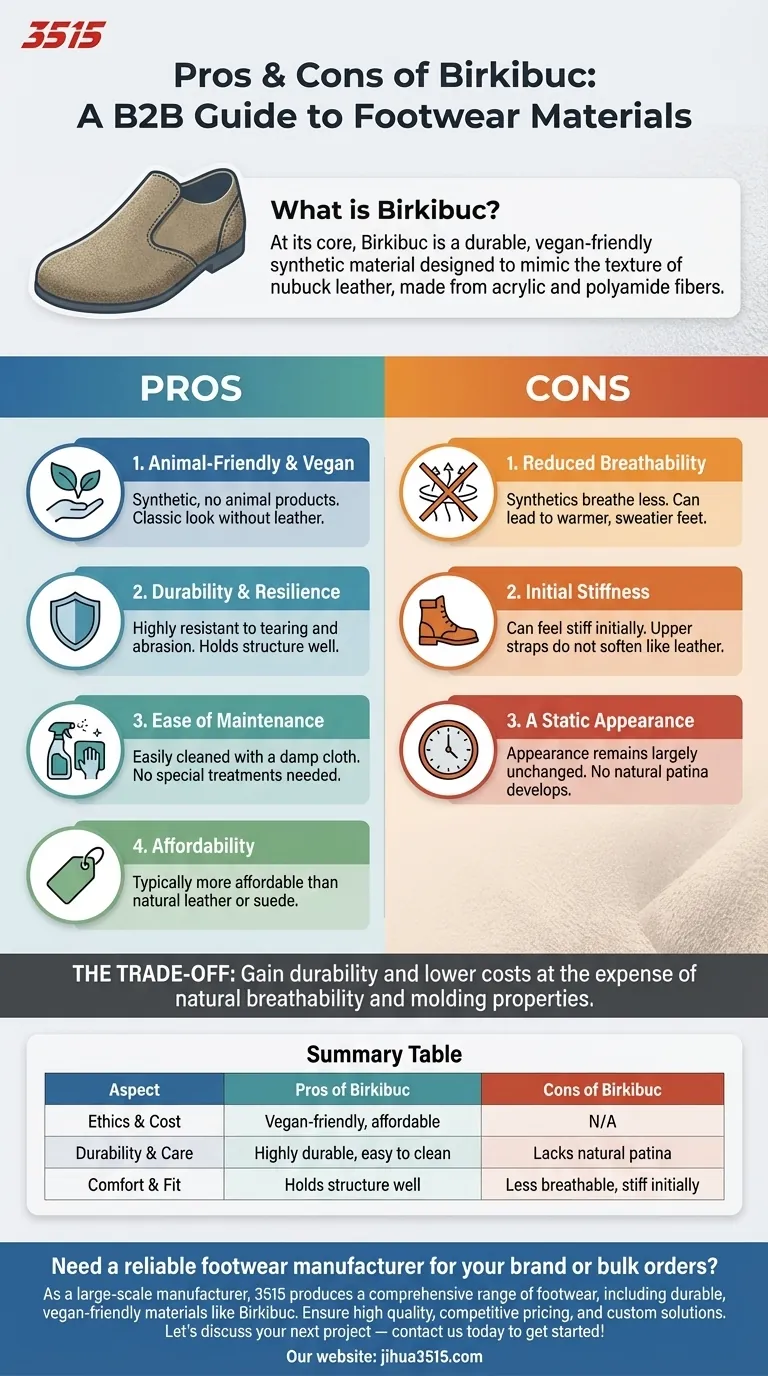At its core, Birkibuc is a durable, vegan-friendly synthetic material designed by Birkenstock to mimic the texture of nubuck leather. Its main advantages are affordability and ease of maintenance, while its primary drawbacks are a lack of breathability compared to natural leather and an initial stiffness that requires a break-in period.
Birkibuc offers a practical and ethical alternative to traditional leather, but this choice involves a direct trade-off: you gain durability and lower costs at the expense of the natural breathability and long-term molding properties inherent to real leather.

What Exactly is Birkibuc?
To make an informed decision, it's important to understand the material's composition and how it's designed to perform.
A Synthetic, Leather-Like Upper
Birkibuc is a proprietary material made from synthetic felt fibers, specifically acrylic and polyamide. It is engineered to look and feel like soft, slightly napped nubuck leather.
Key Characteristics
The material has a soft backing for comfort against the skin and a textured, durable outer layer. Unlike leather, it is entirely man-made and contains no animal products.
The Core Advantages of Birkibuc
Birkibuc is chosen for several practical and ethical reasons that make it a compelling option for many users.
Animal-Friendly and Vegan
As a completely synthetic material, Birkibuc is a popular choice for those who avoid animal products. It provides the classic look of a Birkenstock sandal without using leather or suede.
Durability and Resilience
Birkibuc is highly resistant to tearing and abrasion, making it a very durable option for everyday wear. It holds its structure well over time and is less prone to scuffing than some natural leathers.
Ease of Maintenance
This is one of Birkibuc's strongest selling points. It can be easily cleaned with a damp cloth, requiring no special conditioners or treatments to maintain its appearance.
Affordability
Footwear made with a Birkibuc upper is typically more affordable than the same models made with real leather or suede, offering a lower-cost entry point to the brand.
Understanding the Trade-offs
While practical, the synthetic nature of Birkibuc introduces compromises that are important to consider.
Reduced Breathability
This is the most significant drawback. Synthetic materials like Birkibuc do not breathe as well as natural leather. This can lead to warmer, sweatier feet, especially in hot climates.
Initial Stiffness
Birkibuc can feel stiff right out of the box. While the footbed will still mold to your foot, the upper straps do not soften and conform in the same way that leather does over time.
A Static Appearance
Leather develops a unique patina and character with age. Birkibuc's appearance, by contrast, remains largely unchanged. For some, this is a benefit, as the shoe continues to look new; for others, it lacks the appeal of aged leather.
Making the Right Choice for Your Footwear
Your ideal material depends entirely on your priorities for comfort, cost, and maintenance.
- If your primary focus is affordability and ethics: Birkibuc is an excellent, cost-effective, and vegan-friendly choice.
- If your primary focus is maximum breathability and long-term custom fit: Natural leather, which molds to your foot and breathes better, is likely the superior investment.
- If your primary focus is low maintenance and durability: Birkibuc's simple, wipe-clean nature and robust construction make it the clear winner for hassle-free ownership.
By understanding these fundamental material differences, you can confidently select the footwear that truly aligns with your needs.
Summary Table:
| Aspect | Pros of Birkibuc | Cons of Birkibuc |
|---|---|---|
| Ethics & Cost | Vegan-friendly, more affordable than leather | N/A |
| Durability & Care | Highly durable, easy to clean with a damp cloth | Lacks the natural patina of aged leather |
| Comfort & Fit | Holds structure well over time | Less breathable; can feel stiff initially |
Need a reliable footwear manufacturer for your brand or bulk orders?
As a large-scale manufacturer, 3515 produces a comprehensive range of footwear for distributors, brand owners, and bulk clients. Our production capabilities encompass all types of shoes and boots, including durable, vegan-friendly materials like Birkibuc. We ensure high quality, competitive pricing, and custom solutions tailored to your market.
Let’s discuss your next project — contact us today to get started!
Visual Guide

Related Products
- Durable Rubber-Soled Utility Shoes for Wholesale & Custom Brand Manufacturing
- Wholesale Durable & Breathable Training Shoes for Custom Brands
- Durable Rubber Sole Outdoor Shoes Wholesale & Custom Manufacturing
- Custom OEM Training Shoes Wholesale Manufacturer Durable & Breathable
- Safety Footwear Wholesale Manufacturer for Custom OEM/ODM Production
People Also Ask
- Which type of sole is better for premium sneakers and why? The Definitive Guide to Rubber Outsoles
- What makes rubber sole shoes an economical and practical choice? Unmatched Durability & All-Weather Value
- What is vulcanized rubber and why is it used in products? The Key to Durable, Flexible Footwear
- What are the main applications of vulcanized rubber? Unlock Durability for Tires, Footwear & More
- What are rubber soled shoes? The Ultimate Guide to Durable, All-Weather Footwear



















